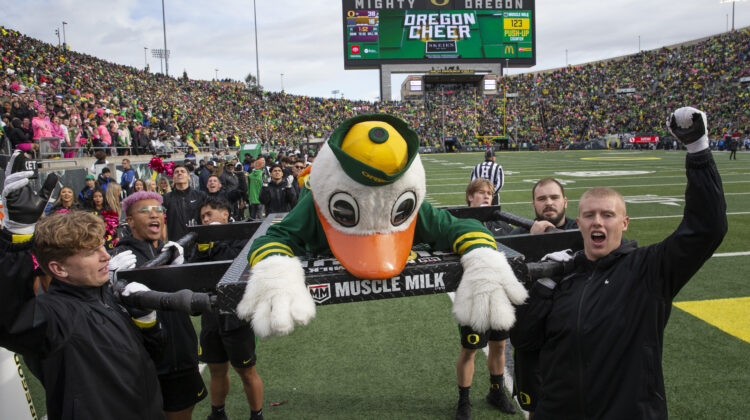Some questions have been edited for clarity and brevity.
Do Oregon and Washington need to give consideration to joining the Big 12? It has been well documented that both schools covet the Big Ten. But the opportunity may not exist today, and they could always join at a later date if/when the opportunity arises. — Andrew Perez
The Hotline doesn’t foresee the Pacific Northwest powers ever joining the Big 12, no matter how dire the Pac-12 situation becomes — even if, for example, the Arizona schools and Utah were to follow Colorado’s lead and flee the conference.
It works both ways: The Big 12 isn’t a good fit for them, and they aren’t good fits for the Big 12.
The reasons are rooted in the financial, logistical and competitive aspects of realignment and conference structure.
First, from the Big 12’s side: Adding Washington and Oregon to a group of newcomers that would include the Four Corners schools would create an 18-team conference — bigger than the Big Ten and SEC and, frankly, too big to function effectively.
To make it work, the Big 12 would need a western division similar to what has been proposed for the Big Ten. But why would the network partners (ESPN and Fox) want a western division that did not include a presence in California? They wouldn’t.
There’s also the competitive issue: Would the likes of Oklahoma State and Baylor welcome two heavyweight football programs that would make playoff access exponentially more difficult for the existing Big 12 members?
From the perspective of the two schools, there are innumerable reasons to decline the Big 12 option. The first, of course, is geography. Can you imagine Washington sending its athletes (in all sports) to Ames, Orlando, Cincinnati and Lubbock on a weekly basis?
Sure, the Huskies would agree to compete on Big Ten campuses if the offer presented itself, but that scenario likely would include transformative revenue and alignment with comparable academic institutions.
In the Big 12 scenario, Washington’s non-revenue sports would be schlepping to and from the Central Time Zone for essentially the same amount of money they would get in the Pac-12. And even if the revenue isn’t fully comparable, the travel isn’t worthwhile. (The same issues exist for the Ducks.)
Yes, USC and UCLA are doing something similar in the Big Ten. But again, they are getting paid well for it.
The competitive issue exists for Oregon to an even greater extent, perhaps, than it does for the Huskies. Why would a football program that has designs on the playoff, and a national title for Phil Knight, want to participate in an 18-team league?
All of which is to say: We don’t envision the Huskies and Ducks participating in the Big 12, ever.
If the Pac-12 loses the Four Corners schools, leaving just the Pacific Northwest quartet and the Bay Area teams, two scenarios would exist:
1. The conference reforms by adding the likes of Boise State and San Diego State to create a league of eight or 10 teams.
2. The Huskies, Ducks and perhaps Cal and Stanford agree to join the Big Ten, likely for reduced revenue shares, thus expediting the creation of the Big Ten’s eight-team western division (with the Los Angeles schools).
The latter scenario feels more plausible and yet, at the same time, not all that plausible.
Was it the 10 university presidents or Pac-12 commissioner George Kliavkoff who decided to demand “north of $40 million” per school per year (and perhaps as much as $50 million) during the contract negotiations with ESPN last fall, if the believable rumors are true? — @Jalex0077
Kliavkoff and his media adviser, Doug Perlman, are in charge of the negotiations — they determined whatever price point was placed on the negotiating table last fall. And yes, we have been told the starting number was in the $40 million vicinity.
What we don’t know is the role UCLA played in the process: Did the conference seek something on the high side of $40 million only in the event the Bruins were forced to reverse course? Or was that figure the target even without the Bruins?
Either way, Kliavkoff’s strategy was to draft off the Big Ten’s negotiated figure of more than $60 million per school per year. Our sources in the media industry were skeptical of the approach and suggested ESPN would be, as well. However, it’s difficult to know what price point would have been acceptable to Oregon and Washington, for instance.
Then the Big 12, desperate for security, renewed its agreement with ESPN and Fox at $31.7 million per school per year. Suddenly, a floor was set for the Pac-12.
Will Kliavkoff secure a valuation that places the Pac-12 on the same level? We should know soon enough: He needs to lock in a proposal in the next few weeks.
Which is the next school to leave the Pac 12: Arizona, Oregon or Washington? — @LouisOliverio
Arizona is clearly the Big 12’s next target. The Wildcats fit geographically and have the basketball brand the Big 12 covets in its 14th member. (Connecticut is also under consideration.)
Commissioner Brett Yormark’s strategy has been obvious (and smart) since last fall: Secure a media deal, then pursue the most receptive Pac-12 school, Colorado, in an attempt to destabilize the league and start a chain reaction.
Perhaps that reaction never materializes. Maybe it only extends to Arizona. Or maybe it leads to the Wildcats, Sun Devils and Utes all leaving for the Big 12.
The saga isn’t over. But to this point, he has completely outmaneuvered Kliavkoff.
As it relates to a potential Arizona defection, would the fact that Arizona and Arizona State share a board of regents potentially complicate any decision to change conferences? — @AmbitiousCoug
This is one of the most significant questions hanging over the fate of the conference: To what extent are the Arizona schools tied together in conference affiliation?
The University of California’s regents didn’t insist that Cal and UCLA remain together, which could provide a model for the governing board in the Grand Canyon State.
We claim no insight on this matter, save for what Arizona president Robert Robbins said during a college athletics forum in June:
“We don’t have to do the same thing. But (ASU president Michael Crow) and I are very, very tight. I think it’d be unlikely that we’d be split up. Right now with 10 schools, we control a very nice 20 percent of solidarity.”
What are Stanford and Cal thinking right now? Certainly, they won’t accept academic lightweights to fill out the conference membership, but what choice do they have? Could they go independent, join the Ivy league or just drop football? — @troyboy8ball
Better question: Who is doing the thinking for the Bay Area schools?
Cal chancellor Carol Christ is retiring next year, and Stanford president Marc Tessier-Lavigne is stepping down next month following an academic scandal.
The schools are staggering on the field, seemingly rudderless in their Ivory Towers and poorly positioned to make any demands, or set any academic requirements for expansion, within the Pac-12 boardroom.
(That’s a huge factor in the broader realignment game, by the way: The Pac-12 would be vastly better positioned to hold its ground if the schools in the nation’s sixth-largest media market were thriving on the field, as Cal did in the 2000s and Stanford did in the 2010s.)
The Cardinal and Bears cannot compete as Independents for financial and competitive reasons — only Notre Dame can thrive in that role — and the Ivy league isn’t an option. (Check back in 15-20 years on that, however.)
We believe their fate is tied to Oregon and Washington, either in the current Pac-12, in a reconfigured Pac-12 or in the Big Ten.
Is there a minimum number of teams the Pac-12 needs to remain eligible for an automatic berth in the College Football Playoff? — @jeffyrocket
Yes, and it’s not an issue.
The NCAA’s minimum requirement to be an officially recognized conference is six members. We asked the CFP about this months ago and were told its qualification process would follow the NCAA requirement.
So in theory, the Pac-12 could lose all the Four Corners schools, then add San Diego State and someone else to reach eight members, and still send its champion to the CFP (as long as it was one of the six highest-ranked conference winners).
That might be just fine with Oregon, which is all about the playoff. But there are obviously a slew of challenges with such an outcome.
What are the 2024 schedule ramifications with only nine schools? — @DmanKeyes
The Pac-12 plays nine conference games, which is, of course, unworkable with only nine schools. Best we can tell, the conference must add a 10th member by next summer.
That’s problematic because of San Diego State’s massive exit fee (approximately $34 million) for leaving the Mountain West with less than 12 months notice.
SMU’s escape route from the American conference is cheaper — probably $18 million, based on precedent — and that could push the Mustangs into the top spot on the Pac-12’s list of expansion candidates.
San Diego State has had much more football and men’s basketball success than Colorado, and you can argue it’s in a better market. Would a one-for-one swap be a net upgrade for the Pac-12? — @_alexwakefield
While the San Diego media market isn’t quite as large as Denver and the surrounding area, according to Nielsen, it’s close enough to be immaterial. And from a recruiting standpoint, SDSU’s location is substantially more important to the Pac-12.
Meanwhile, the Aztecs’ major sports have performed better than Colorado’s versions over the past decade.
So yes, that swap would constitute an upgrade on several fronts.
With Colorado’s departure, do you see the Pac-12 adding three schools? — @WHS1969
The bold play at this point would be to add multiple schools at reduced revenue shares — some combination of San Diego State, SMU and Gonzaga, for instance.
But anyone expecting bold action from the Pac-12 presidents is setting themselves up for disappointment.
The group talks about a strategic approach that anticipates “where the puck is going.” In reality, it’s unable to see the puck until the conference gets whacked in the mouth.
Do you feel that you have been misled by your sources inside the Pac-12?— @KenRhodes23
Not at all, and here’s the reason: To a significant extent, our coverage of the media rights process has leaned into 1) sources in the sports media industry who are unaffiliated with the conference, and 2) on-the-record comments by the university presidents.
That reliance on industry sources is precisely why the Hotline has viewed Pac-12 survival as no more than a 4-point favorite over extinction — that’s roughly equivalent to a 60 percent probability — throughout the spring and summer. (The line has been lowered to 2.5 points following Colorado’s departure, by the way.)
It’s why we have always described a media deal that satisfied the 10 schools as “the most likely outcome” and not as a given.
And it’s why we have written ad nauseam since January that time and risk move in lockstep: The longer Kliavkoff waited to secure a deal, the greater the risk of presidential panic or external forces leading to defections and possible implosion.
I won’t get into details about Hotline sources for obvious reasons. But hopefully, that explanation provides some context on our coverage.
How would you grade Kliavkoff’s performance to this point? — @miles_adkisson
The Hotline long ago committed to waiting out the media rights negotiations before rendering a verdict on Kliavkoff.
Yes, he was dealt a difficult hand by his predecessor, Larry Scott. But this is what he was hired to do. Construct a media deal. Find new sources of revenue. Put the conference in position to thrive.
(The Pac-12 presidents opted against hiring someone from inside college sports because they wanted an expert in media rights and revenue generation.)
We’ll withhold judgment out of fairness to Kliavkoff, so an incomplete grade remains on the report card.
Related posts:

(AP Photo/Ralph Freso, File)
Wilner Hotline: Sun Devils Missing in Action, Week 10 Pac-12 Picks
(AP Photo/Ralph Freso, File)
Wilner Hotline – Five Hot Names for Next Oregon Football Coach
Oregon wide receiver Johnny Johnson III (3) Eugene, Ore. (AP Photo/Andy Nelson)
Wilner Hotline – Oregon Ducks Hire First-Time Head Coach Wilner Hotline – Oregon Collapse, No Holiday for UCLA
Wilner Hotline – Oregon Collapse, No Holiday for UCLA
